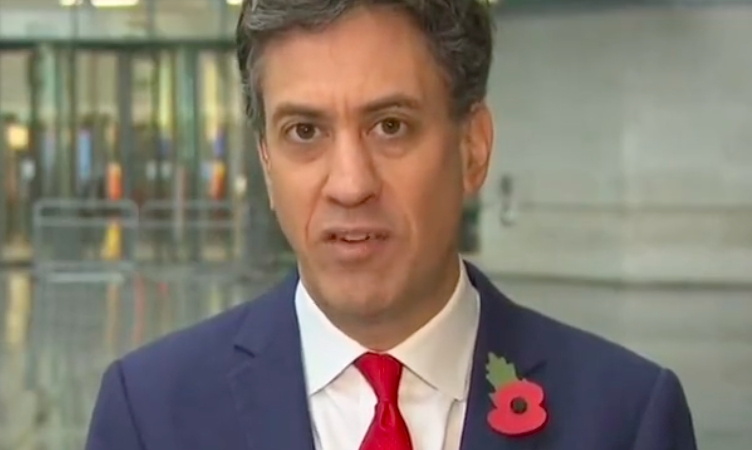Ed Miliband hits back at Trump’s denials of climate change
13 November, 2024
Left Foot Forward
Left Foot Forward
The WMO has said that 2015-2024 will be the warmest ten years on record with the loss of ice from glaciers, sea-level rises and ocean heating acceleration.

Labour’s Ed Miliband, Secretary of State for Energy Security and Net Zero, has hit back at Trump’s claims that climate change is a hoax as he pledged to do all he could to ensure Britain is at the forefront of the Green transition.
Trump has often denied the evidence of climate change and only a few months ago called climate change ‘one of the great scams’ following the destruction caused by Hurricane Helene, which killed more than 100 people, across the southeast US.
The world has seen increasing wildfires, droughts and record temperatures in recent years, with the World Meteorological Organization (WMO) issuing a red alert on the first day of the UN Climate Change Conference, COP29.
The WMO has said that 2015-2024 will be the warmest ten years on record with the loss of ice from glaciers, sea-level rises and ocean heating acceleration, while extreme weather, like Spain’s recent floods and hurricanes that battered the USA, is wreaking havoc on communities and economies across the world.
“Climate catastrophe is hammering health, widening inequalities, harming sustainable development, and rocking the foundations of peace. The vulnerable are hardest hit,” said UN Secretary-General António Guterres.
Miliband was asked about President-elect Trump’s denial of climate change, to which he replied: “I don’t believe it’s a hoax. It’s real, just look at events in Spain. Look at the fact that we had a 40 degree day in Britain two years ago, look at what’s happening in the U.S. It’s definitely happening.”
Asked about what the government’s message will be to Trump, Miliband replied: “The
message for us is we’re going to do what’s in our national self-interest’.
Must watch: Right-wing arguments on climate change dismantled in a single clip

The right have spent many years undermining the fight against climate change, from denying scientific evidence, to shifting the goalposts by claiming the policies designed to tackle catastrophic climate change are ‘too costly’.
With Trump winning the US election, some are feeling emboldened, as they try to pressure the Labour government to drop policies aimed at tackling climate change.
In the latest example of an attempt to discredit climate change policies, the founder of right-wing blog Guido Fawkes, Paul Staines, told LBC: “You can’t power a metropolis off batteries, it’s just not going to happen.”
Guardian journalist Zoe Williams replied: “Work has been done in the right-wing’s attempt to block measures to combat climate change.
“You follow it over a 25 year period, first it went climate change isn’t real, then it went climate change is real but it won’t be that bad, then it went climate change is real and it will be that bad and now it’s gone to climate change is real it will be that bad but there’s nothing that we can do about it.
“The fact is we have to do something, Keir Starmer might annoy you but we still have to do something, wind power might look a bit sketchy to you but we still have to do something…if it’s not working you have to find a way to make it work otherwise you end up with catastrophic climate events, which people are ending up with anyway, just look at Valencia.
“Seriously, stop bringing problems to the table and start bringing solutions.”
She went on to add: “You’re basically saying to people who believe in renewables, you can just give up your dream of renewables because it’s just not going to work, now the truth is Paul…if we move faster on hydrogen than we did under the Tory government, then we would have a framework for delivering hydrogen and we can start doing that now, if we moved faster on wind or batteries, all of these things would be achievable if we just moved faster.”
Basit Mahmood is editor of Left Foot Forward
“Seriously, stop bringing problems to the table and start bringing solutions.”

The right have spent many years undermining the fight against climate change, from denying scientific evidence, to shifting the goalposts by claiming the policies designed to tackle catastrophic climate change are ‘too costly’.
With Trump winning the US election, some are feeling emboldened, as they try to pressure the Labour government to drop policies aimed at tackling climate change.
In the latest example of an attempt to discredit climate change policies, the founder of right-wing blog Guido Fawkes, Paul Staines, told LBC: “You can’t power a metropolis off batteries, it’s just not going to happen.”
Guardian journalist Zoe Williams replied: “Work has been done in the right-wing’s attempt to block measures to combat climate change.
“You follow it over a 25 year period, first it went climate change isn’t real, then it went climate change is real but it won’t be that bad, then it went climate change is real and it will be that bad and now it’s gone to climate change is real it will be that bad but there’s nothing that we can do about it.
“The fact is we have to do something, Keir Starmer might annoy you but we still have to do something, wind power might look a bit sketchy to you but we still have to do something…if it’s not working you have to find a way to make it work otherwise you end up with catastrophic climate events, which people are ending up with anyway, just look at Valencia.
“Seriously, stop bringing problems to the table and start bringing solutions.”
She went on to add: “You’re basically saying to people who believe in renewables, you can just give up your dream of renewables because it’s just not going to work, now the truth is Paul…if we move faster on hydrogen than we did under the Tory government, then we would have a framework for delivering hydrogen and we can start doing that now, if we moved faster on wind or batteries, all of these things would be achievable if we just moved faster.”
Basit Mahmood is editor of Left Foot Forward



